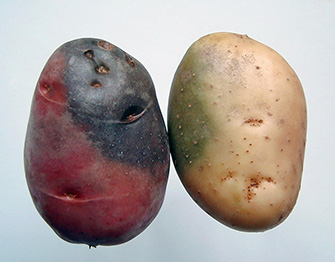Please click here to access the main AHDB website and other sectors.
- Home
- Knowledge library
- Greening
Greening
Exposure of tubers to light, either in the field or during storage, will result in the formation of chloroplasts that contain chlorophyll. This is the green pigment associated with the irreversible condition called greening.

Although greening itself has no health implications, exposure to light also leads to the formation of the glycoalkeloids solanine and chaconine. These are toxic in high enough concentrations and are produced naturally by the potato as part of its defence mechanism.
It is because of this that there is a very tight tolerance on quality specifications for greening.
The level of greening is dependant on the variety, the wavelength and intensity of light, exposure time and temperature.
Identification
As tubers are exposed to light, the skin and surface tissues will show the green pigment first.
As greening becomes more intense, the affected area will change from a light green to a very dark green.
On tubers with a red skin, the green pigment can appear to be purple. The depth of greening will also increase as exposure increases.
Greening is best observed on a washed tuber, as this is how a prepack sample will be seen.
For processing, very light surface greening may be acceptable if it is removed with a single peel stroke, if the load is to be peeled.
Control
The aim during growth is to keep the tubers within the ridge profile to avoid contact with light.
Seed potatoes should be planted at the right depth for the seed size and variety and in a wide enough ridge in order to avoid tubers pushing through the side of the ridge during the bulking phase.
In some varieties and certain seasons, daughter tubers may initiate further from the mother tuber which can lead to increased levels of greening.
Erosion of the ridge from either wind, rain or irrigation can lead to tuber exposure and greening.
Also, if the ridge becomes too dry it may crack, leading to tuber exposure, especially during the lodging phase.
Post-harvest, potatoes should be covered at all times during transport and lights should not be left on unnecessarily during storage, which over a long storage period will lead to light greening on the surface of the pile or top boxes.

